Richard Taylor’s wife, Joyce, suffered from respiratory distress syndrome. He noticed that she only had relief when in a clean hospital room. So in 1990, he designed an air purifier that used True Medical HEPA and activated carbon to clean the air inside his home. Within a week of using the first device, Joyce could sleep undisturbed for the first time in years. That was the start of Austin Air.
Now, it’s one of the world’s largest air cleaning manufacturers, with a reported revenue of $19.2 million. What makes this brand stand out is that Austin Air purifiers use much more activated carbon than what is typically found in traditional consumer air purifiers, with around 15 lbs of carbon and zeolite in the HealthMate I am reviewing today.
While this means that Austin Air purifiers are among the highest-priced on the market, they are great at removing gases, odors and VOCs that standard air purifiers find much harder to remove. Austin Air was tested by the U.S. Army and fulfilled the largest deployment of air purifiers in American history to support the air quality concerns in post-9/11 NYC.
As with every air purifier review we publish here at HouseFresh, we bought the Austin Air HealthMate Standard (B400B1) with our own money to remain unbiased.
The pros and cons of the Austin Air HealthMate
A summary of our top-level findings after testing this air purifier following our methodology.

“The Austin Air HealthMate is the best air purifier on the market for dealing with severe air quality issues connected to chemical gasses, unwanted odors and VOCs.
However, with its 15 lbs of carbon and a price that surpasses $700, this device is overkill for those looking to keep dust and pollen levels low due to its high initial and running costs.”

HouseFresh Founder
& Lead Tester
CONS
PROS
| Clean air delivery rate (CADR): | – Top speed PM1 CADR: 156 cfm – Sub-45 dBA PM1 CADR: 77 cfm – AHAM PM2.5 CADR: 154 cfm (dust) |
| Filter technology: | HEPA particle filter with 15 lb of activated carbon and zeolite mix gas filter |
| Recommended room size: | 234 sq. ft. (5 air changes per hour) |
| Dimensions: | 23H x 14.5W x 14.5D inches (58.4H x 36.8W x 36.8D cm) |
| Weight: | 20.41 lbs (9.26 kg) |
| Noise level in decibels from 3 ft. away: | Speed 1: 42.5 dB Speed 2: 53.2 dB Speed 3: 61.5 dB |
| Electricity consumption in watts: | Standby mode: 0 watts Speed 1: 61.1 watts Speed 2: 85.05 watts Speed 3: 147.6 watts |
| Filter lifespan: | 5 years |
| Manufacturer’s warranty: | 5 years |
| Country of origin: | United States |
| Country of manufacture: | United States (Buffalo, New York) |
The best feature: a large amount of activated carbon and zeolite
The Austin Air HealthMate comes with a HEPA filter and a whooping 15 lbs of carbon and zeolite.
This is the largest amount of carbon we have encountered in a filter across the nearly 100 air purifiers we have tested.
However, at over $700, this air purifier will be out of budget for most people. That is why I particularly want to highlight it for those of you wanting to remove harmful VOCs and unwanted odors from your air, as that is the one use case where spending $700 will make the most sense.
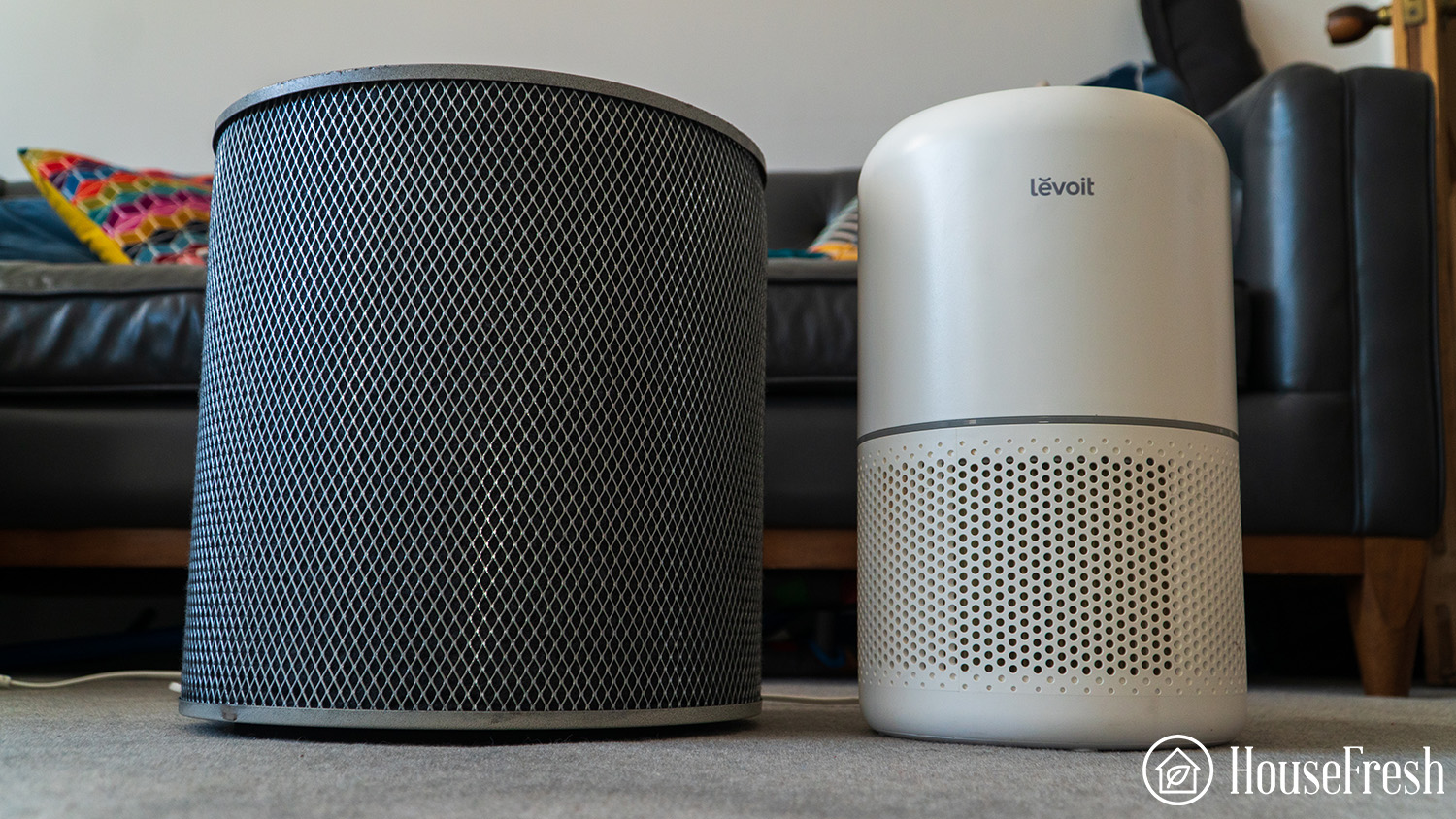
The closest I can make would be the IQAir HealthPro Plus, which costs around $900 and also comes with powerful HEPA filtration and a gas filter that combines activated carbon and zeolite, too.
The one thing I will say about the HealthPro Plus is that it performed better in our particle removal test, cleaning the air of PM1 pollutants in 28 minutes compared to the 52 minutes it took for the Austin Air HealthMate to achieve the same result.
Now, the big difference between the two is that the HealthPro Plus comes with only 5 lbs of carbon compared to the 15 lbs of carbon you get with the HealthMate.
Design, controls and features
Functional design elements that do the job without any bells and whistles.
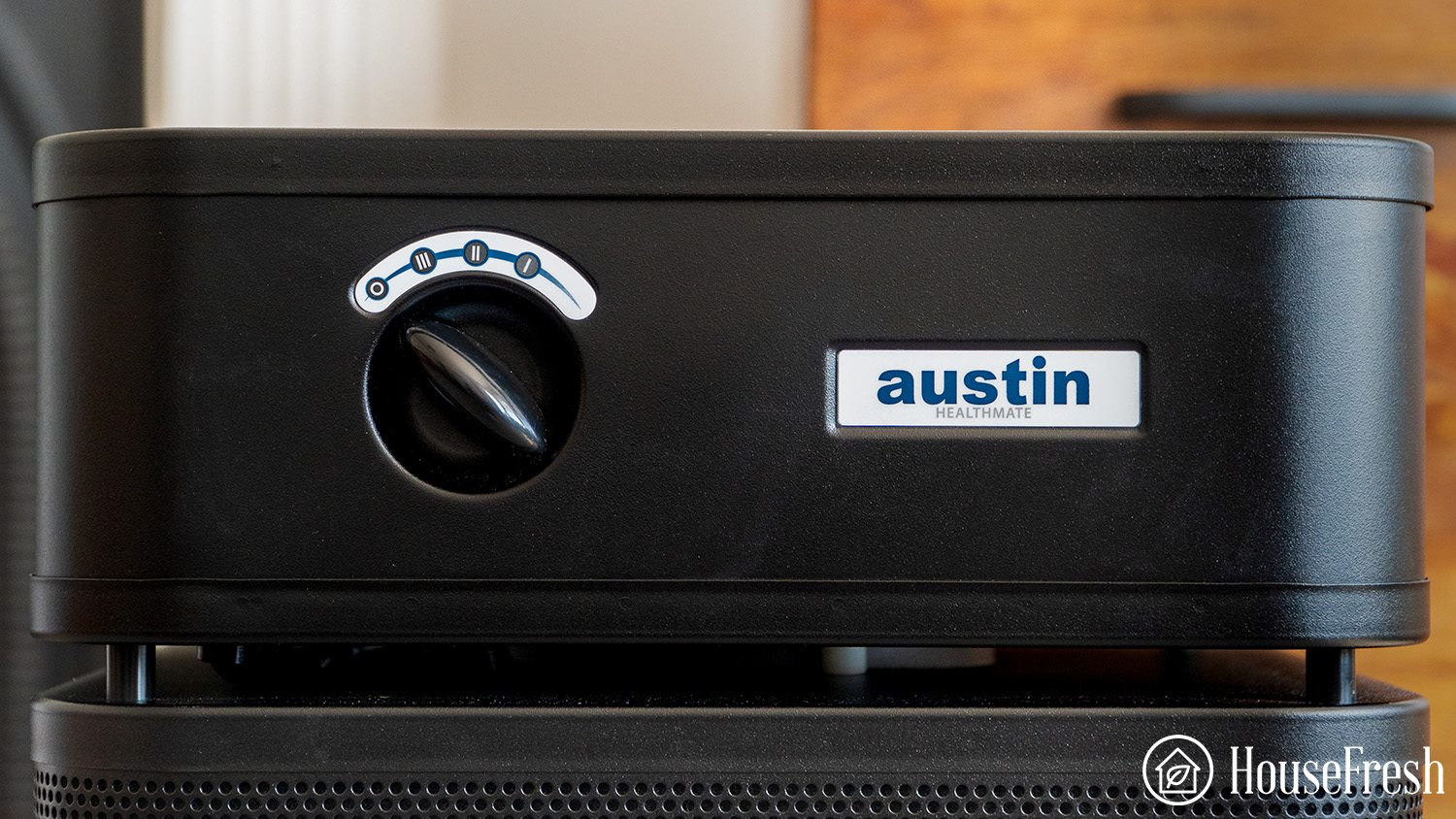
The HealthMate is one of the largest air purifiers we tested, based on weight and dimensions.
The HealthMate has a simple 3-function switch for switching the unit on and for changing the fan speed.
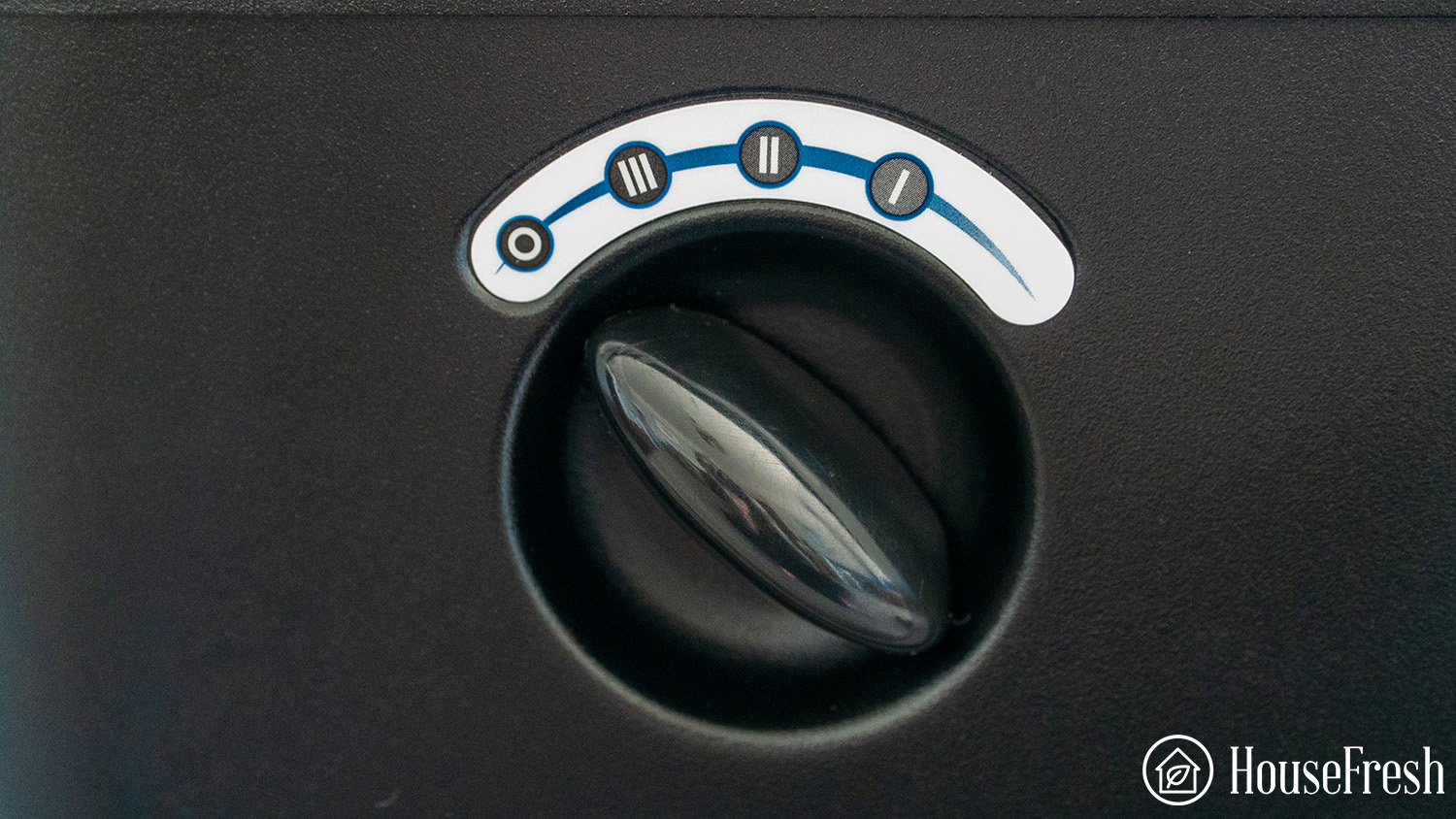
The top of the device is flat and can make a handy side table:

With a body made out of metal and a MASSIVE filter, this is a heavy air purifier that weighs 47 lbs (21.3 kg).
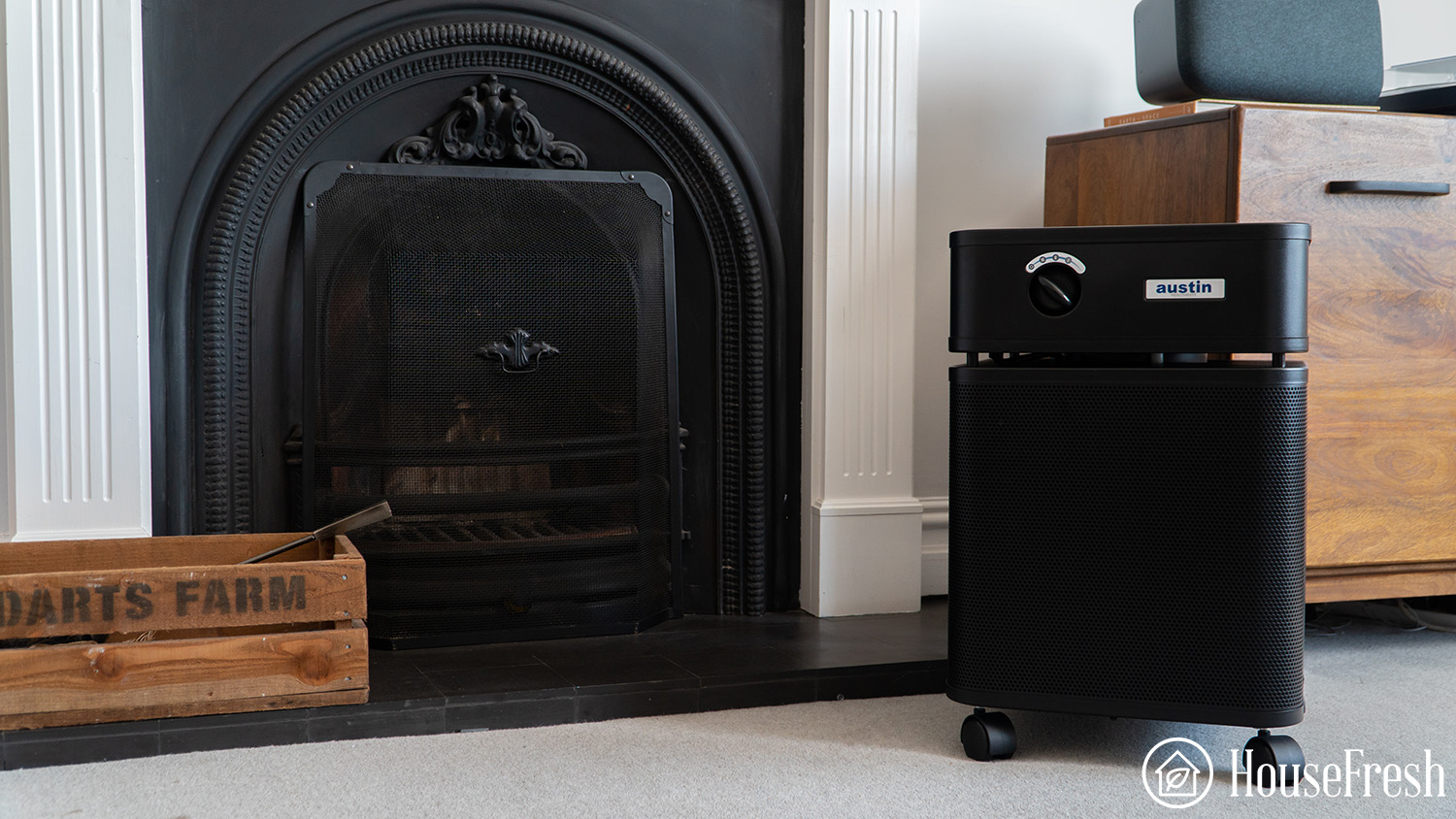
Luckily, it comes on wheels that make it easy to move around the house.
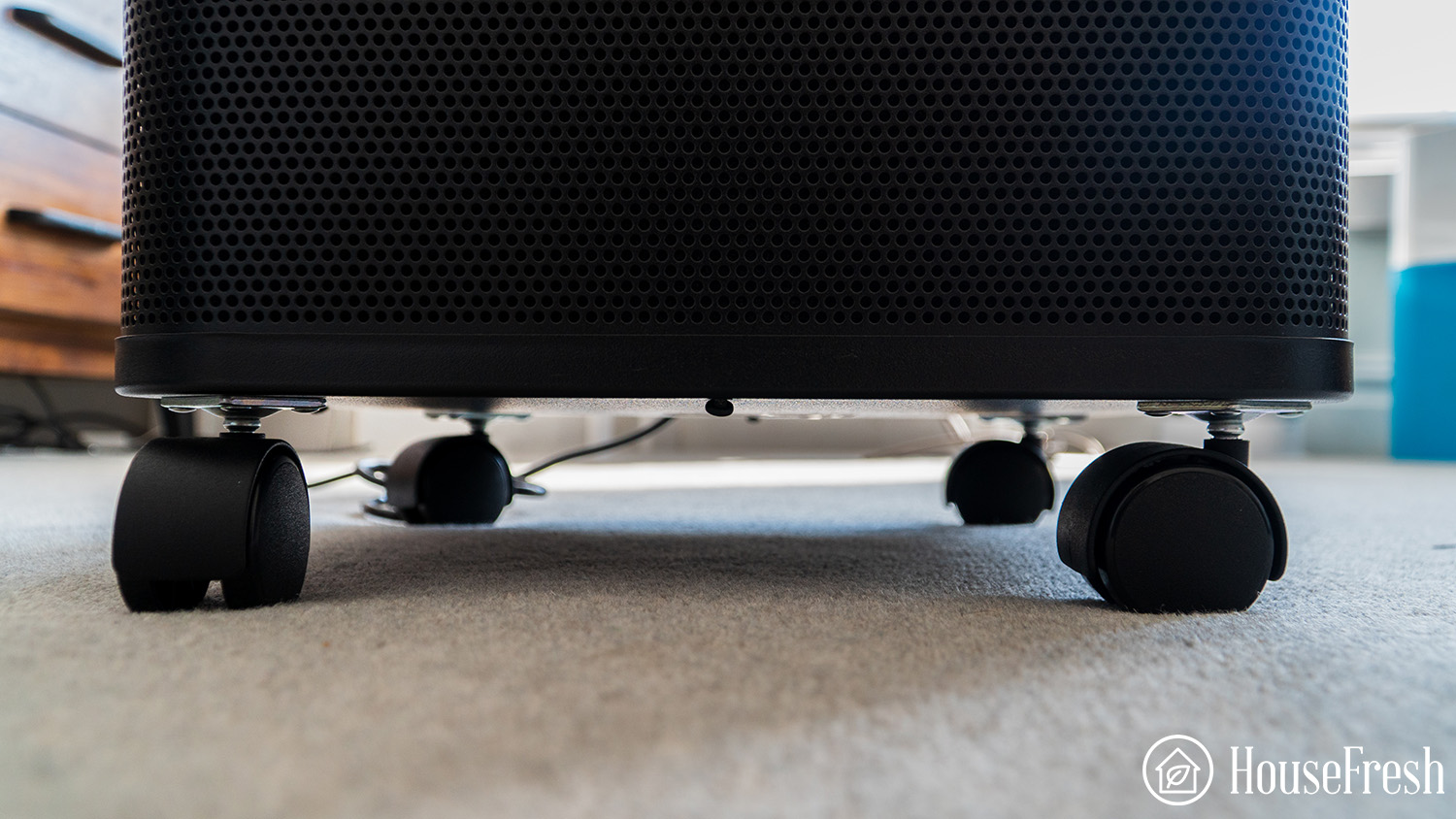
“With infrequent filter changes, the Austin Air is cheaper to own than almost every other heavy-carbon-HEPA air purifier on the market.
But at 45 pounds HealthMate NEEDS the four caster type wheels to get around, and may prove difficult for the elderly or infirm to move about the home, or upstairs.”

Air-Purifier-Power
Founder
When it comes to its size, we’re talking about an air purifier that will need its fair share of space. However, when compared side-by-side with its biggest competitor (the IQAir HealthPro Plus), you can see that even though the HealthMate has a similar floor footprint but is a much shorter unit.
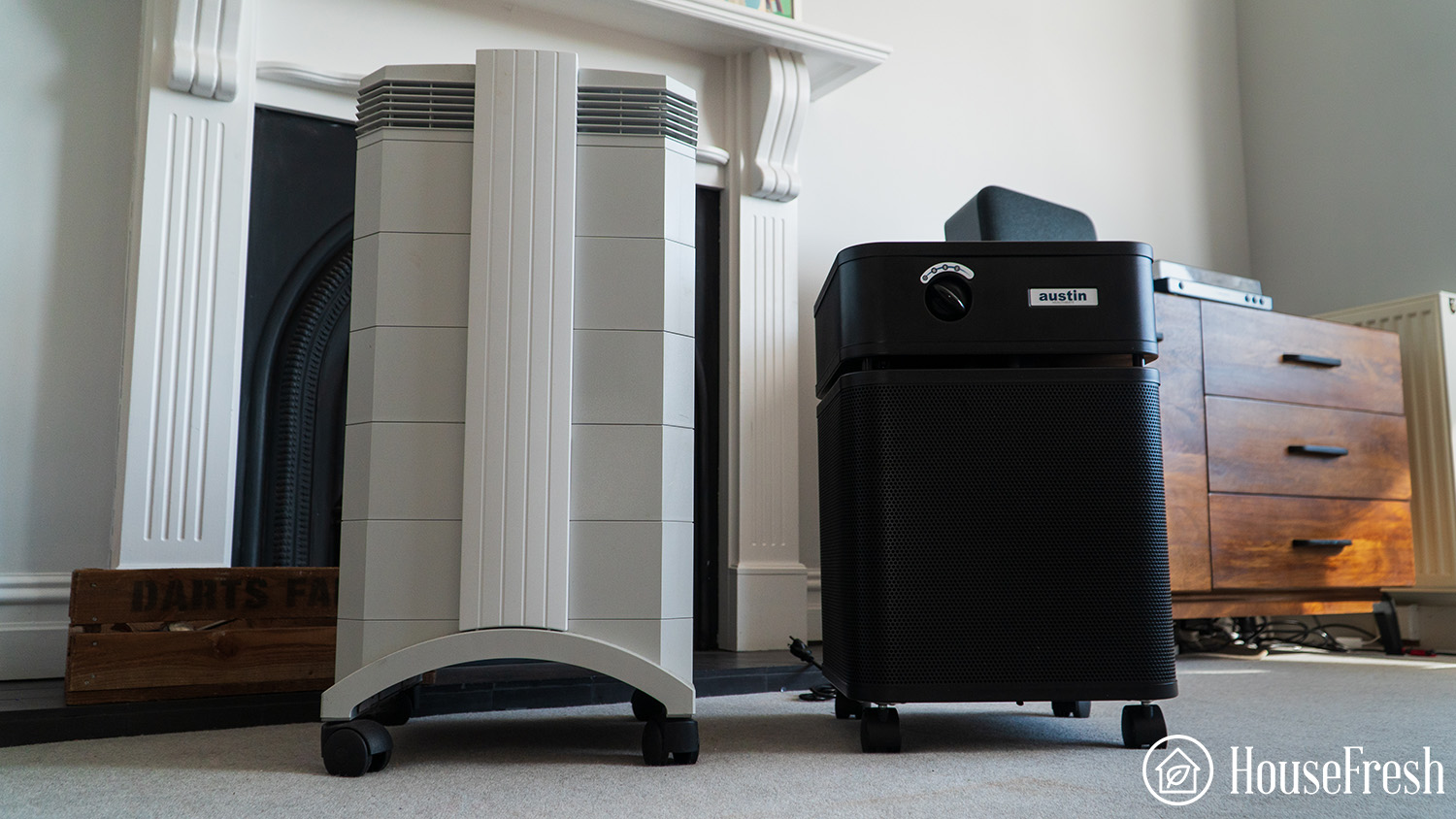
Filtration technology
The Austin Air HealthMate comes with a True HEPA filter and 15 lbs of carbon + zeolite mix.

Most air purifiers use a HEPA-based filter with a small amount of activated carbon via impregnated fabric or small pellets. The reason that small amounts of carbon are used is down to price and can quickly increase costs for the initial unit and replacement filters.
If you are dealing with unwanted odors and VOCs, you need the biggest amount of activated carbon available. The filter inside the HealthMate comes with 15 lbs of activated carbon and zeolite.
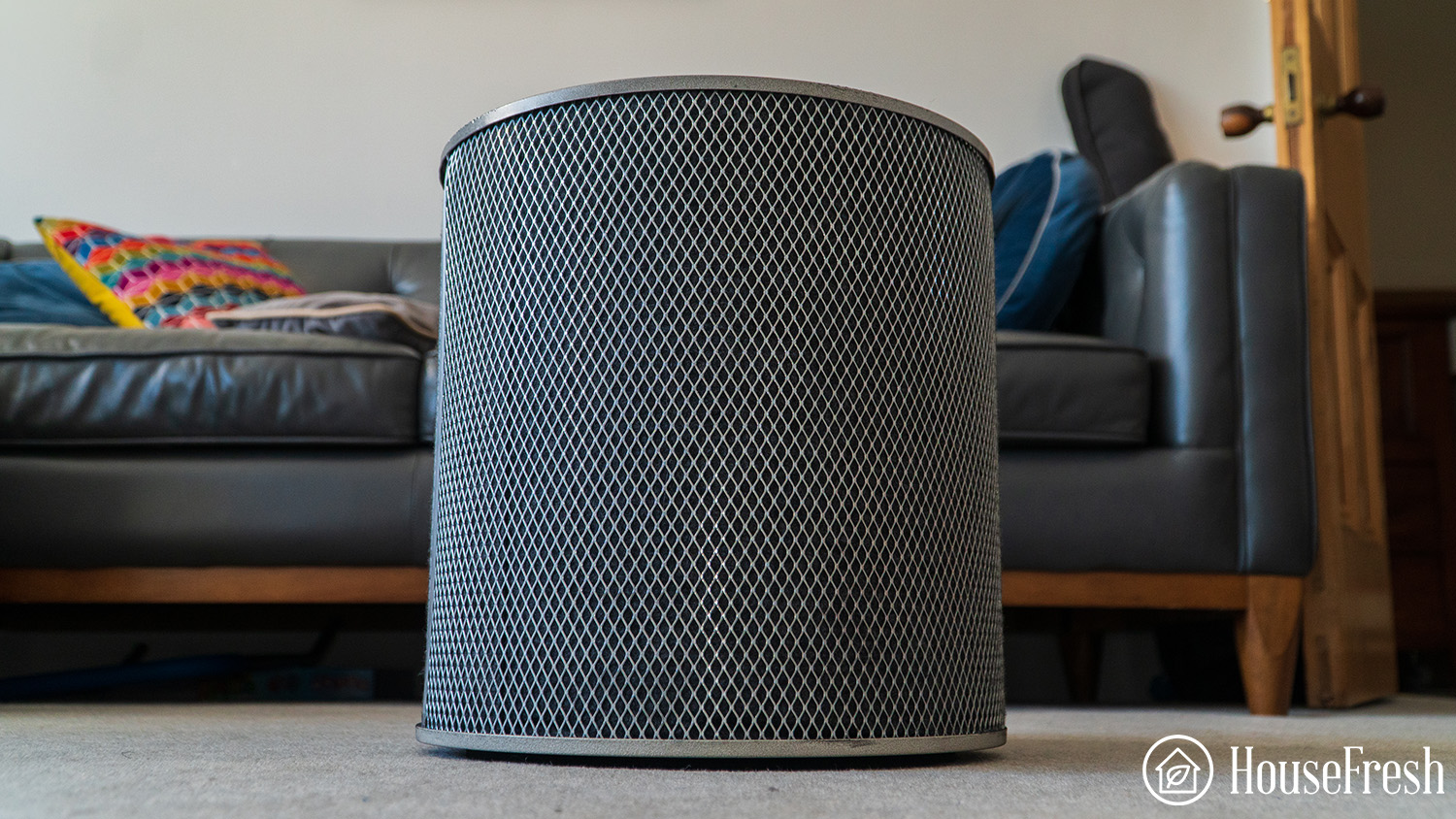
It is worth mentioning that replacing the filter in the HealthMate is not as straightforward as with other air purifiers I have tested. You will need a screwdriver:
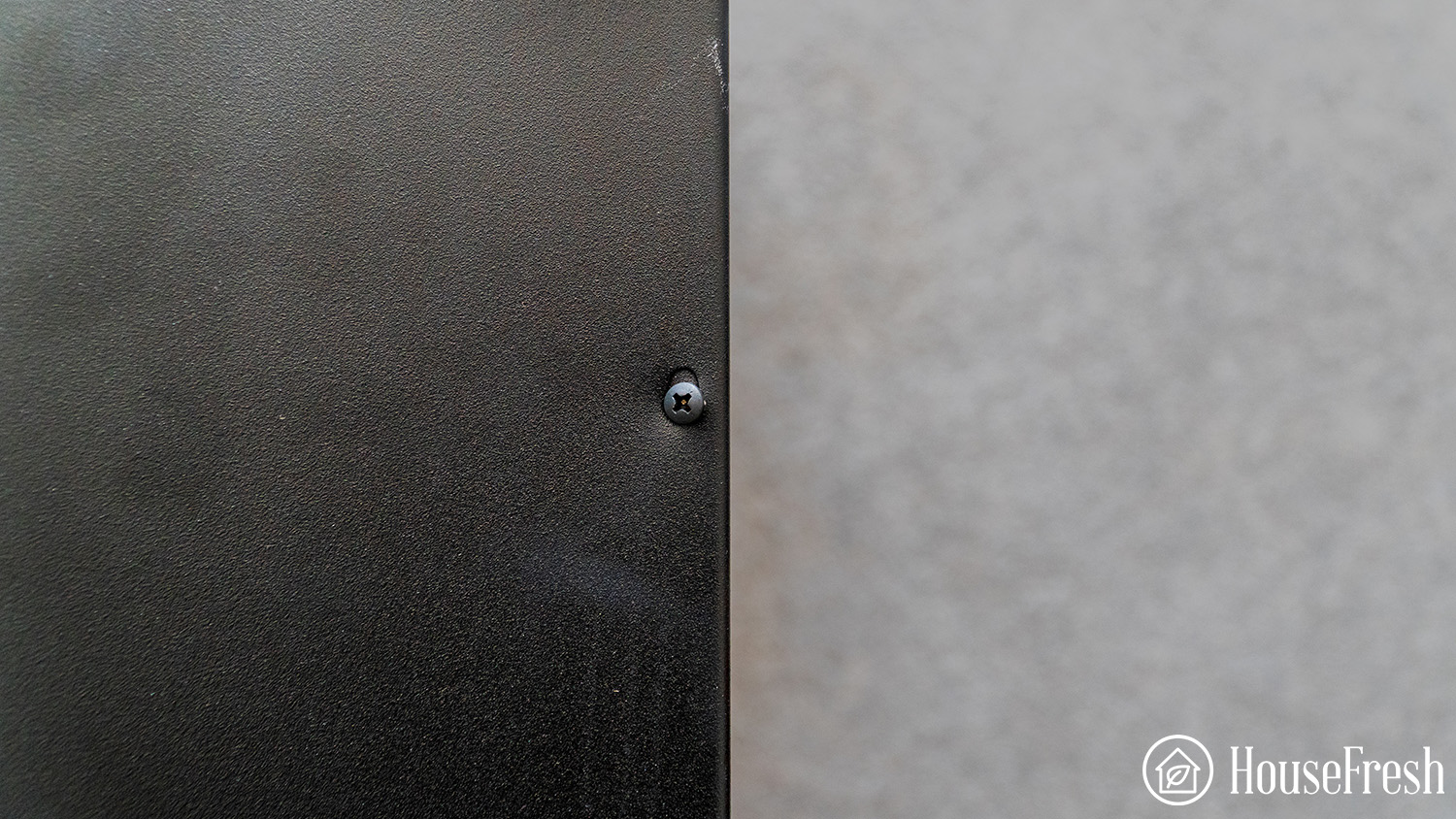
Once you have detached the top of the unit from its body, you will be able to access the filter. Here is how it looks inside:
Air cleaning performance
We tested the HealthMate in our 728 cubic ft. test room, tracking how fast it removed all PM1 particles from the air after we filled the space with incense stick.

According to our PurpleAir Zen sensor, the HealthMate needed 52 minutes to achieve PM1 zero in our 728 cubic ft. test room. We estimate a PM1 CADR of 156 cfm.
But this information in isolation probably doesn’t mean much to you, so I made a table to show you how the performance of the Austin Air HealthMate compares to other devices we have tested:
| AIR PURIFIER MODEL | TIME TO REACH PM1 ZERO AT FULL SPEED | LIST PRICE |
|---|---|---|
| Smart Air Blast Mini MKII | 15 minutes | $649.00 |
| Levoit EverestAir | 16 minutes | $499.99 |
| Alen BreatheSmart 45i | 30 minutes | $429.00 |
| Winix 5500-2 | 23 minutes | $249.99 |
| Rabbit Air A3 | 24 minutes | $749.95 |
| Coway Airmega AP-1512hh Mighty | 26 minutes | $229.99 |
| IQAir HealthPro Plus | 28 minutes | $1000.00 |
| AirDoctor 3000 | 30 minutes | $519.00 |
| Austin Air HealthMate | 52 minutes | $756.00 |
If this air purifier were to have been designed with the focus of removing particles from the air, then the results could be seen as unimpressive, considering that it cleaned our test room at a similar rate to the Levoit Core 300 (54 minutes), which is available for $99.
But you must consider that the Austin Air is designed to remove gasses and VOCs due to its larger-than-normal activated carbon and zeolite filter. And the thing with large amounts of carbon is that they restrict airflow, so this will have an effect in the particle removal performance of this air purifier.
Luckily our upgraded Purple Air Indoor sensor has the latest BME68 sensor that allows us to also track the level of VOCs in the air.
Removing gasses takes much longer and even with the large filter of the Austin Air HealthMate, you can see that VOC levels are drastically reduced over the next few hours after we perform our particle test. By 2 p.m., we had reduced the level of VOC from 433.65ppm to 50.52ppm.
Sound levels
The sound levels of the Austin Air HealthMate range from 42 dBA to 61.5 dBA — this matches what we saw with the IQAir HealthPro Plus (61.2 dBA at top speed).
As part of our testing, we use a sound level meter to measure how much noise each of the air purifiers we review generates at each fan speed.
| Speed | Sound Level |
| 1 | 42.0 dB |
| 2 | 53.2 dB |
| 3 | 61.5 dB |
This is how this compares to other devices we tested:
| AIR PURIFIER MODEL | SOUND LEVEL AT TOP SPEED (dB) | TIME TO CLEAN OUR TEST ROOM |
|---|---|---|
| Smart Air Blast Mini MKII | 56.3 dB | 15 minutes |
| Levoit EverestAir | 57.8 dB | 16 minutes |
| Coway Airmega AP-1512hh Mighty | 60.1 dB | 25 minutes |
| IQAir Healthpro Plus | 61.2 dB | 28 minutes |
| Austin Air HealthMate HM400 | 61.5 dB | 52 minutes |
| AirDoctor 3000 | 63.6 dB | 20 minutes |
The ability to remove VOCs will likely require a more substantial fan to push the air through the large filter, so more noise is expected. While it’s not painfully loud, it would be too loud if you had to work in the same room.
That being said, I know that noise is subjective. Have a listen for yourself so you can assess whether the Austin Air HealthMate is too noisy for you.
I re-tested the particle removal performance of the HealthMate at its only sub-45 dBA fan speed (speed 1 @ 42 dBA) and it needed 76 minutes to reach PM1 zero:
Long-term running costs
Running a Austin Air HealthMate will cost you $226.95 per year, combining energy consumption costs and filter replacement prices.
As with all the air purifier reviews we publish here at HouseFresh, we did the math to calculate how much you should budget to run this specific device for a year accounting for energy costs and filter replacement costs.
First, we used a power meter to measure just how much electricity the HealthMate consumes at each of its fan speeds:
| Fan speed | Energy consumed |
| 1 | 61.1 watts |
| 2 | 85.05 watts |
| 3 | 147.6 watts |
This means that it would cost you $163.95 in energy costs for a year, based on 24/7 usage at top speed at the average U.S. energy rate.
The replacement filters for the HealthMate costs a whopping price of $315. Luckily, you only need to replace the filter every five years, which will translate into $63 per year in filter replacement costs.
Check the table below to compare the yearly running costs of an Austin Air HealthMate with what you can expect to pay with other similarly-priced and popular air purifiers:
| AIR PURIFIER MODEL | ESTIMATED ELECTRICITY COST (per year) | FILTER REPLACEMENT COST (per year) | YEARLY MAINTENANCE COST |
|---|---|---|---|
| Coway Airmega AP-1512hh Mighty | $83.64 | $39.99 | $123.63 |
| Winix 5500-2 | $57.82 | $79.99 | $137.81 |
| Levoit EverestAir | $73.58 | $99.99 | $173.57 |
| Smart Air SA600 | $56.55 | $141.47 | $198.02 |
| AirDoctor 3000 | $104.63 | $178.00 | $282.63 |
| Austin Air HealthMate | $164.39 | $57.90 | $283.03 |
| Smart Air Blast Mini MKII | $136.29 | $236.99 | $373.28 |
| IQAir HealthPro Plus | $221.47 | $200.00 | $421.47 |
Bottom line: Should you get an Austin Air HealthMate?
This is the best air purifier on the market today if you have serious issues with VOCs or odors. Otherwise, you should look into cheaper units.
If you have health concerns that tie back to VOCs or are experiencing significant issues with gasses, you can’t get much better than the Austin Air HealthMate and its 15 lbs of activated carbon and zeolite.
However, for the vast majority of use cases, spending $700+ on this device will be overkill and unnecessary.

The HealthMate comes with much more activated carbon than the IQAir HealthPro Plus (5 lbs VS 15 lbs) and is cheaper to buy and run. But when it comes to particle removal performance, the HealthPro Plus will offer you better bang for your buck – even at its higher price.
So for those looking for the best air purifier for dealing with serious VOCs, then the Austin Air HealthMate is definitely a top contender. But if you are just looking for a good air purifier that will help with common kitchen odors, dust and pollen, then you will be able to find a device for a fraction of the price in our list of the best air purifiers we recommend right now.
And if you’re looking at the HealthMate because you’re looking for an air purifier made in the USA, then you should also check out the Luggable XL-7 from the team at CleanAirKits. It doesn’t come with activated carbon so it will be useless against odors and gases but its particle removal performance is INCREDIBLE, it is whisper quiet thanks to the use of PC fans AND all the DIY kits are made in the USA.
SOURCES
We calculated yearly costs associated with running the Austin Air Health Mate 24 hours a day, 365 days per year utilizing the appliance electricity consumption calculator from the U.S. Department of Energy as of January 2025.

